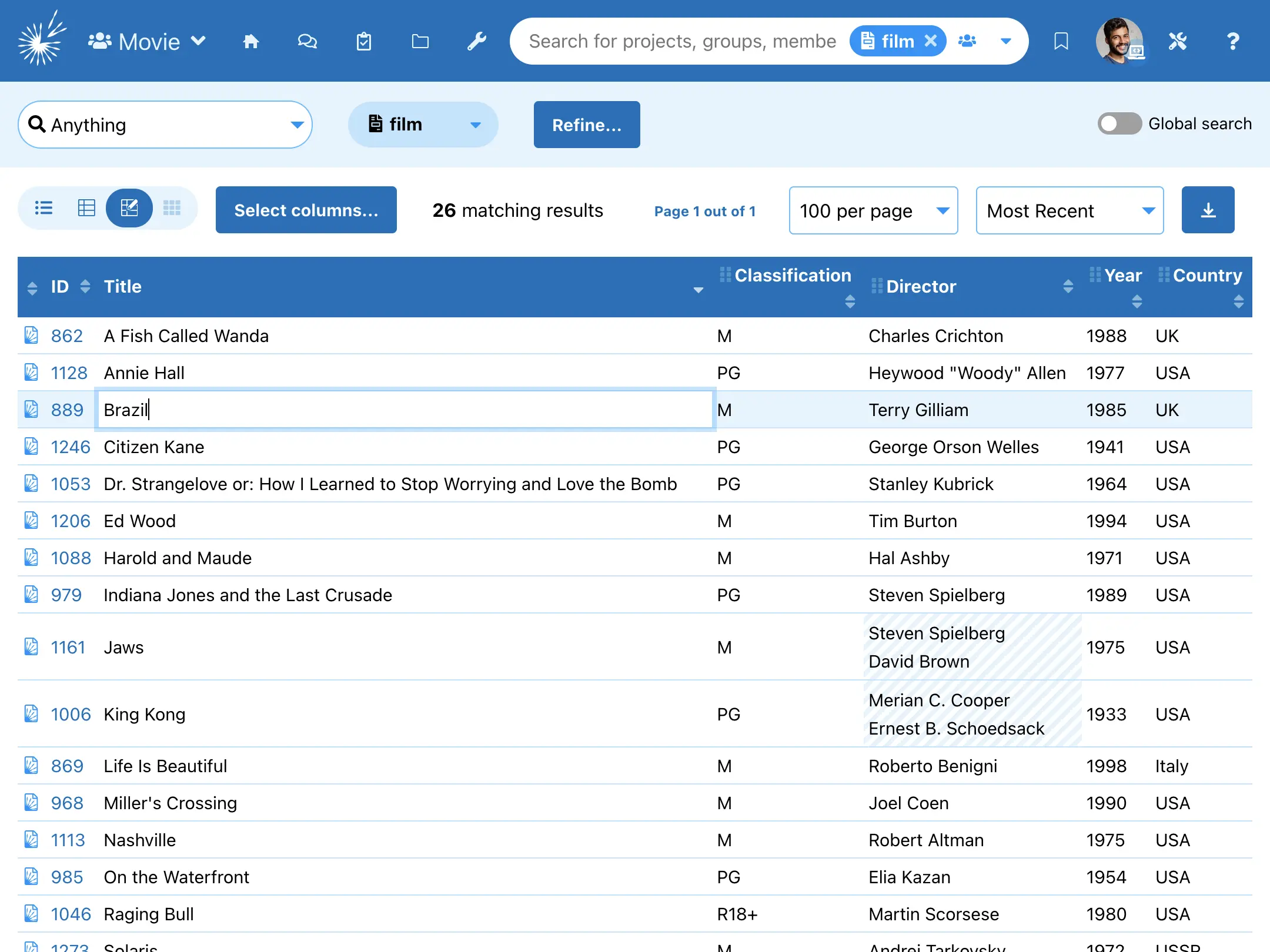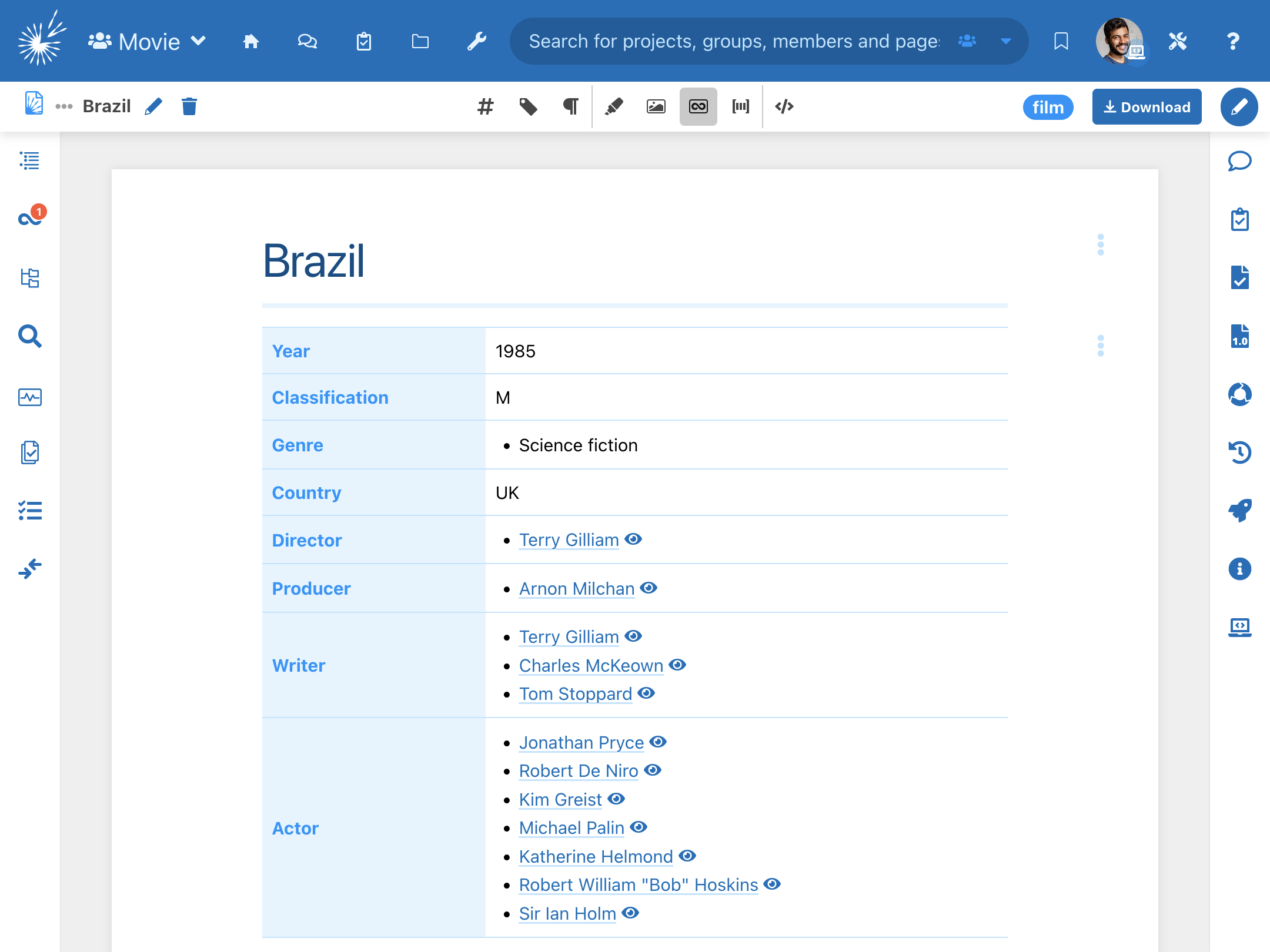Entity / relationship pattern
Background
One of the modeling patterns supported by PageSeeder will be familiar to anyone with knowledge of Entity Relationship Diagrams (ERDs). As a long time tool for relational database developers and analysts, the following screen might help to illustrate how a PageSeeder document type can be thought of as the equivalent of a relational table.

Similarly, what appears as a row in the view above, appears more like a record in the following screenshot. In the following screen, the value of a column in the table view looks like a field in the record view.
Finally, if the name of the director was an xref to a biographical document, this would look like a join.

Based on these fundamental concepts, this article looks at an example of a book with a publisher and multiple authors in more detail. An Entity-relationship diagram, such as the one following, is a useful tool for modeling. When expressing the diagram, make each type of content an entity then label certain fields and each relationship with the appropriate cardinality (for example, N..1, N..M).
PageSeeder concepts
Cross-references (xrefs)
In PageSeeder, the rich references between documents are called xrefs. They have many properties – the ones relevant to this example are:
- link type – is a processing instruction that tells PageSeeder, when exporting, what to do with the linked content – whether it is a simple reference or whether the content is to be included.
- reverse link – whether we want the reference to be visible to the document being referenced.
The model could be used to generate detail to be included in the front matter of a book. In that case, we’d want the links between the book and the other documents to be embed, so that when the document was processed, that information could be included.
We’d also want the reverse links to be true between the book and the author, to be available, so from the Author document we could easily see all the books they’d authored.
Document types
PageSeeder lets you define specific document types that can capture very specifically the object you’re trying to describe. A PageSeeder document is comprised of:
- sections – a section within a PageSeeder document is used to organize content – you can lock a section or limit the fragment types that are available.
- fragments – the basic content unit for PageSeeder – fragments contain all of the content. They can be of different types, ranging from limiting the content to a fixed set of properties or allowing for rich content to be added. A history is kept for each fragment within a document.
A document type is a specific combination of sections, fragment types and fragments that is sympathetic to the data that is being captured.
Book
The book document properties:
- Title – text.
- ISBN – text, with validated format.
- Author(s) – xref to one or more Author documents.
- Publisher – single xref to publisher document.
Author
The Author document property:
- Name – Text.
Publisher
The Publisher document properties:
- Name – Text.
- Address – Text.
PSML representation
In book ER model could be implemented in PSML using the following rules:
- A document type for each entity.
- A
<property>for each field. To improve user productivity and quality of data, consider creating a custom editor PSMLPropertiesConfig for each data set. - Create a
<property>of@datatype="xref"to express each of the following relationships: - 1 to 1.
- 0..1 to 0..1.
- Create a
<property>of@datatype="xref"at the N end of each following relationship. It is possible to use a@count="n"or an<xref-fragment>from the 1 end of the relationship, but if N is a large number, this makes editing cumbersome. - 1 to N.
- 0..1 to N.
- Create an
<xref-fragment>for each following relationship. To reduce the number of xrefs being edited this is usually done from the end for which N or M is largest. - N to M.
- 0..N to 0..M.
Remember that xrefs only need to be created at one end of the relationship, with the reverse xrefs being created automatically.
Following are examples of the resulting PSML documents, along with some advice on additional configuration options.
Book
<document level="portable" type="book">
<section id="details">
<properties-fragment id="1">
<property name="title"
title="Title"
value="My story"/>
<property name="isbn"
title="ISBN"
value="0864412345"/>
<property name="category"
title="Category"
value="Fiction"/>
<property name="publisher"
datatype="xref"
title="Publisher">
<xref type="none"
frag="default"
href="../../publishers/00/publisher-001.psml">
XYZ Books
</xref>
</property>
</properties-fragment>
</section>
<section id="authors" title="Authors">
<xref-fragment id="2">
<blockxref type="none"
frag="default"
href="../../authors/00/author-001.psml">
John Jones</blockxref>
<blockxref type="none"
frag="default"
href="../../authors/00/author-002.psml">
Jane Black
</blockxref>
</xref-fragment>
</section>
</document>
Cardinality
PageSeeder is very flexible in how the document types are constructed, but once they are set up they can enforce the model.
The 1..N relationship between publishers and books is enforced by expressing the relationship as a single reference from the book to the publisher. This way, the publisher can be referred to by many books and a book can only refer to one publisher.
File naming
Where multiple files need to be created, the document-config.xml can be used to automatically spawn files with unique, sequentially numbered filenames in a designated folder.
For example, to populate a folder called books with files that start with the name:
/books/00/book-001.psml
This code could be added to the document config:
<creation>
<title>Book</title>
<folder context="/books" path="{0P1000}" />
<filename value="book-{NNN}" editable="false"/>
<document title="Book {N} {$ui.title}" docid="B{0000N}" />
</creation>
To support multiple collections of the same entity, use a * wildcard in the @context attribute of the <folder> element. For example, @context="/libraries/*/books" would create books under
/libraries/mytown/books/00/book-001.psml
or
/libraries/yourtown/books/00/book-001.psml
Be aware of potential naming clashes when using PageSeeder to generate names at the same time as creating documents externally and then uploading them to PageSeeder. Use a prefix (for example, book-x001.psml) or some other technique to prevent confusion.
Xrefs
To auto-suggest the correct document type in an <xref-fragment>, edit the editor-config.xml similar to the following example:
<editor-configs>
<editor-config name="PSMLXRefs">
<xref-config fragmenttype="default">
<xref type="none"/>
<target documenttype="author" />
</xref-config>
</editor-config>
</editor-configs>
Where the target document type is in multiple collections, the auto-suggest can be further restricted by adding <autosuggest> with @folder under <xref-config>. For example:
<editor-configs>
<editor-config name="PSMLXRefs">
<xref-config fragmenttype="default">
<xref type="none"/>
<target documenttype="author" />
<autosuggest folder="libraries/*" />
</xref-config>
</editor-config>
</editor-configs>
In this example, the * is replaced with the context of the current document. For example:
libraries/mytown
Author
<document level="portable" type="author">
<section id="details">
<properties-fragment id="1">
<property name="author"
title="Author"
value="John Jones"/>
</properties-fragment>
</section>
</document>
Publisher
<document level="portable" type="publisher">
<section id="details">
<properties-fragment id="1">
<property name="publisher"
title="Publisher"
value="XYZ Books"/>
<property name="address"
title="Address"
value="P.O. Box 123, My City"/>
</properties-fragment>
</section>
</document>
